Prediction of Student Academic Performance Using a Hybrid 2D CNN Model
Abstract
1. Introduction
- Can hybrid 2D CNN architecture be applied to numerical 1D educational-domain data to predict students’ academic performance?
- To combine two different CNN models with different numbers of convolution layers and pooling layers to produce a single hybrid CNN model in the EDM field.
2. Literature Review
3. Method
3.1. Data Preprocessing
3.2. 2D Representation
3.3. Approach
- Take the input data and reshape each datum to 2D to obtain each input datum of size W × H × D.
- For the first convolutional layer, define the total number of filters, K; filter size, F; and stride step, S, and calculate the output feature map with a size of , where:
- The feature map, , is an input to the first pooling layer. For the first pooling layer, define filter size, F, and stride step, S, and calculate the output of the size of , where:
- For the second convolutional layer, define the total number of filters, K; filter size, F; and stride step, S, and calculate the output feature map with a size of , where:
- For the third convolutional layer, define the total number of filters, K; filter size, F; and stride step, S, and calculate the output feature map with a size of , where:
- The output of step 5 is converted to the single-layer 1D vector in the first flattened layer.
- For the fourth convolutional layer, the input is the original input with a size of W × H × D. Calculate the output feature map with a size of , where:
- For the second pooling layer, define the filter size, F, and stride step S, and calculate the output with a size of , where:
- For the fifth convolutional layer, define the total number of filters, K; filter size, F; and stride step, S, and calculate the output feature map with a size of , where:
- The output of step 9 is converted to the single-layer 1D vector in the second flattened layer.
- Concatenate the output obtained from steps 6 and 9 to produce a 1D long vector, which becomes the input to the fully connected layer.
- Define the number of input neurons and output neurons for the first dense layer. Pass the output to the second dense layer.
- For the second dense layer, define the output neurons as the total number of classes in our dataset.
- Predict the label and calculate the accuracy.
4. Experimentation and Evaluation
4.1. Evaluation with Baseline Model and Previous Studies
5. Implications of Results
6. Conclusions
Author Contributions
Funding
Institutional Review Board Statement
Data Availability Statement
Acknowledgments
Conflicts of Interest
References
- Here’s How Much Your High School Grades Predict Your Future Salary. Available online: https://www.washingtonpost.com/news/wonk/wp/2014/05/20/heres-how-much-your-high-school-grades-predict-how-much-you-make-today/ (accessed on 2 November 2021).
- Koh, H.; Tan, G. Data mining applications in healthcare. J. Healthc. Inf. Manag. 2005, 19, 64–72. [Google Scholar] [PubMed]
- Sodhro, A.H.; Zahid, N. AI-Enabled Framework for Fog Computing Driven E-Healthcare Applications. Sensors 2021, 21, 8039. [Google Scholar] [CrossRef] [PubMed]
- Vazan, P.; Janikova, D.; Tanuska, P.; Kebisek, M.; Cervenanska, Z. Using data mining methods for manufacturing process control. IFAC-Pap. 2017, 50, 6178–6183. [Google Scholar] [CrossRef]
- Awoyemi, J.O.; Adetunmbi, A.O.; Oluwadare, S.A. Credit card fraud detection using machine learning techniques: A comparative analysis. In Proceedings of the International Conference on Computing Networking and Informatics (ICCNI), Lagos, Nigeria, 29–31 October 2017. [Google Scholar]
- Lan, K.; Wang, D.; Fong, S. A Survey of Data Mining and Deep Learning in Bioinformatics. J. Med. Syst. 2018, 42, 139. [Google Scholar] [CrossRef] [PubMed]
- Farzaneh, A.; Fadlalla, A. Data mining applications in accounting: A review of the literature and organizing framework. Int. J. Account. Inf. Syst. 2017, 24, 32–58. [Google Scholar]
- Ghosh, I.; Datta Chaudhuri, T. FEB-Stacking and FEB-DNN Models for Stock Trend Prediction: A Performance Analysis for Pre and Post COVID-19 Periods. Decis. Mak. Appl. Manag. Eng. 2021, 4, 51–84. [Google Scholar] [CrossRef]
- Shah, C.; Du, Q.; Xu, Y. Enhanced TabNet: Attentive Interpretable Tabular Learning for Hyperspectral Image Classification. Remote Sens. 2022, 14, 716. [Google Scholar] [CrossRef]
- More Students are Learning on Laptops and Tablets in Class. Some Parents Want to Hit the Off Switch. Available online: https://www.washingtonpost.com/local/education/more-students-are-learning-on-laptops-and-tablets-in-class-some-parents-want-to-hit-the-off-switch/2020/02/01/d53134d0-db1e-11e9-a688-303693fb4b0b_story.html (accessed on 1 November 2021).
- Get the 411: Laptops and Tablets in the Classroom. Available online: https://www.educationworld.com/a_tech/tech/tech194.shtml (accessed on 25 September 2021).
- How to Implement 1:1 Technology using Tablets in the Classroom. Available online: https://myelearningworld.com/10-benefits-of-tablets-in-the-classroom/ (accessed on 28 September 2021).
- Virtual Reality in Education: Benefits, Tools, and Resources. Available online: https://soeonline.american.edu/blog/benefits-of-virtual-reality-in-education (accessed on 25 September 2021).
- Hasan, R.; Palaniappan, S.; Mahmood, S.; Abbas, A.; Sarker, K.U.; Sattar, M.U. Predicting Student Performance in Higher Educational Institutions Using Video Learning Analytics and Data Mining Techniques. Appl. Sci. 2020, 10, 3894. [Google Scholar] [CrossRef]
- Nagahi, M.; Jaradat, R.; Nagahisarchoghaei, M.; Ghanbari, G.; Poudyal, S.; Goerger, S. Effect of Individual Differences in Predicting Engineering Students’ Performance: A Case of Education for Sustainable Development. In Proceedings of the International Conference on Decision Aid Sciences and Applications (DASA), Online, 8–9 November 2020. [Google Scholar]
- Okubo, F.; Yamashita, T.; Shimada, A.; Ogata, H. A neural network approach for students’ performance prediction. In Proceedings of the Seventh International Learning Analytics & Knowledge Conference (LAK ‘17), Vancouver, BC, Canada, 13–17 March 2017; Association for Computing Machinery: New York, NY, USA, 2017. [Google Scholar]
- Byung-Hak, K.; Ethan, V.; Ganapathi, V. GritNet: Student Performance Prediction with Deep Learning. arXiv 2018, arXiv:1804.07405. [Google Scholar]
- Wang, W.; Yu, H.; Miao, C. Deep Model for Dropout Prediction in MOOCs. In Proceedings of the 2nd International Conference on Crowd Science and Engineering (ICCSE’17), Beijing, China, 6–9 July 2017. [Google Scholar]
- Whitehill, J.; Mohan, K.; Seaton, D.; Rosen, Y.; Tingley, D. Delving Deeper into MOOC Student Dropout Prediction. arXiv 2017, arXiv:1702.06404. [Google Scholar]
- Xing, W.; Dongping, D. Dropout Prediction in MOOCs: Using Deep Learning for Personalized Intervention. J. Educ. Comput. Res. 2019, 57, 547–570. [Google Scholar] [CrossRef]
- Bohong, Y.; Zeping, Y.; Hong, L.; Yaqian, Z.; Jinkai, X. In-classroom learning analytics based on student behavior, topic and teaching characteristic mining. Pattern Recognit. Lett. 2020, 129, 224–231. [Google Scholar]
- Nigel, B.K.; D’mello, S.; Ocumpaugh, J.; Baker, R.; Shute, V. Using Video to Automatically Detect Learner Affect in Computer-Enabled Classrooms. ACM Trans. Interact. Intell. Syst. 2016, 6, 1–26. [Google Scholar]
- Goldberg, P.; Sümer, O.; Stürmer, K. Attentive or Not? Toward a Machine Learning Approach to Assessing Students’ Visible Engagement in Classroom Instruction. Educ. Psychol. 2021, 33, 27–49. [Google Scholar] [CrossRef]
- Cetintas, S.; Si, L.; Xin, P.; Hord, C. Automatic Detection of Off-Task Behaviors in Intelligent Tutoring Systems with Machine Learning Techniques. IEEE Trans. Learn. Technol. 2010, 3, 228–236. [Google Scholar] [CrossRef]
- Zaletelj, J.; Košir, A. Predicting students’ attention in the classroom from Kinect facial and body features. J. Image Video Proc. 2017, 80, 80. [Google Scholar] [CrossRef]
- Antoniou, P.E.; Arfaras, G.; Pandria, N.; Athanasiou, A.; Ntakakis, G.; Babatsikos, E.; Bamidis, P. Biosensor real-time affective analytics in virtual and mixed reality medical education serious games: Cohort study. JMIR Serious Games 2020, 8, e17823. [Google Scholar] [CrossRef] [PubMed]
- Ahonen, L.; Cowley, B.U.; Hellas, A.; Puolamaki, K. Biosignals reflect pair-dynamics in collaborative work: EDA and ECG study of pair-programming in a classroom environment. Sci. Rep. 2018, 8, 3138. [Google Scholar] [CrossRef] [PubMed]
- Magsi, H.; Sodhro, A.H.; Al-Rakhami, M.S.; Zahid, N.; Pirbhulal, S.; Wang, L. A Novel Adaptive Battery-Aware Algorithm for Data Transmission in IoT-Based Healthcare Applications. Electronics 2021, 10, 367. [Google Scholar] [CrossRef]
- Sumyea, H.; Jiuyong, L.; Lin, L.; Esmaeil, E.; Shane, D.; Duncan, M.; Qi, L. Predicting academic performance by considering student heterogeneity. Knowl. Based Syst. 2018, 161, 134–146. [Google Scholar]
- Hussain, S.; Abdulaziz Dahan, N.; Ba-Alwib, F.; Najoua, R. Educational Data Mining and Analysis of Students’ Academic Performance Using WEKA. Indones. J. Electr. Eng. Comput. Sci. 2018, 9, 447–459. [Google Scholar] [CrossRef]
- Sharma, A.; Vans, E.; Shigemizu, D. DeepInsight: A methodology to transform a non-image data to an image for convolution neural network architecture. Sci. Rep. 2019, 9, 11399. [Google Scholar] [CrossRef] [PubMed]
- Loka, N.R.B.S.; Kavitha, M.; Kurita, T. Hilbert Vector Convolutional Neural Network: 2D Neural Network on 1D Data. In Proceedings of the International Conference on Artificial Neural Networks (ICANN), Munich, Germany, 17–19 September 2019. [Google Scholar]
- Al-Turaiki, I.; Altwaijry, N. A Convolutional Neural Network for Improved Anomaly-Based Network Intrusion Detection. Big Data 2021, 9, 233–252. [Google Scholar] [CrossRef]
- Nagahisarchoghaei, M.; Dodd, J.; Nagahi, M.; Ghanbari, G.; Poudyal, S. Analysis of a Warranty-Based Quality Management System in the Construction Industry. In Proceedings of the International Conference on Data Analytics for Business and Industry: Way Towards a Sustainable Economy (ICDABI), Online, 26–27 October 2020. [Google Scholar] [CrossRef]
- Shah, C.; Du, Q. Modified Structure-Aware Collaborative Representation for Hyperspectral Image Classification. In Proceedings of the 2021 IEEE International Geoscience and Remote Sensing Symposium IGARSS, Brussels, Belgium, 11–16 July 2021. [Google Scholar]
- Shah, C.; Du, Q. Spatial-Aware Collaboration-Competition Preserving Graph Embedding for hyperspectral image classification. IEEE Geosci. Remote Sens. Lett. 2021, 19, 1–5. [Google Scholar] [CrossRef]
- Shah, C.; Du, Q. Collaborative and Low-Rank Graph for Discriminant Analysis of Hyperspectral Imagery. IEEE J. Sel. Top. Appl. Earth Obs. Remote. Sens. 2021, 14, 5248–5259. [Google Scholar] [CrossRef]
- Aulck, L.; Velagapudi, N.; Blumenstock, J.; West, J. Predicting student dropout in higher education. In Proceedings of the ICML Workshop on #Data4Good: Machine Learning in Social Good Applications, New York, NY, USA, 24 June 2016; Available online: https://arxiv.org/pdf/1606.06364.pdf (accessed on 28 September 2021).
- Daud, A.; Aljohani, N.R.; Abbasi, R.A.; Lytras, M.D.; Abbas, F.; Alowibdi, J.S. Predicting student performance using advanced learning analytics. In Proceedings of the 26th International Conference on World Wide Web Companion, Perth, Australia, 3–7 April 2017. [Google Scholar] [CrossRef]
- Garg, R. Predicting student performance of different regions of Punjab using classification techniques. Int. J. Adv. Res. Comput. Sci. 2018, 9, 236–241. [Google Scholar] [CrossRef][Green Version]
- Kemper, L.; Vorhoff, G.; Wigger, B.U. Predicting student dropout: A machine learning approach. Eur. J. High. Educ. 2020, 10, 28–47. [Google Scholar] [CrossRef]
- Aluko, R.O.; Daniel, E.I.; Oshodi, O.S.; Aigbavboa, C.O.; Abisuga, A.O. Towards reliable prediction of academic performance of architecture students using data mining techniques. J. Eng. Des. Technol. 2018, 16, 385–397. [Google Scholar] [CrossRef]
- Luhaybi, M.A.; Tucker, A.; Yousefi, L. The prediction of student failure using classification methods: A case study. Comput. Sci. Inf. Technol. 2018, 79–90. [Google Scholar] [CrossRef]
- Asif, R.; Merceron, A.; Ali, S.A.; Haider, N. Analyzing undergraduate students’ performance using educational data mining. Comput. Educ. 2017, 113, 177–194. [Google Scholar] [CrossRef]
- Li, F.; Zhang, Y.; Chen, M.; Gao, K. Which Factors Have the Greatest Impact on Student’s Performance. J. Phys. Conf. Ser. 2019, 1288, 012077. [Google Scholar] [CrossRef]
- Francis, B.K.; Babu, S.S. Predicting Academic Performance of Students Using a Hybrid Data Mining Approach. J. Med. Syst. 2019, 43, 162. [Google Scholar] [CrossRef] [PubMed]
- Hussain, M.; Zhu, W.; Zhang, W.; Abidi, S.M.R. Student Engagement Predictions in an e-Learning System and Their Impact on Student Course Assessment Scores. Comput. Intell. Neurosci. 2018, 2018, 6347186. [Google Scholar] [CrossRef] [PubMed]
- Heuer, H.; Breiter, A. Student success prediction and the trade-off between Big data and data minimization. In DeLFI 2018—Die 16. E-Learning Fachtagung Informatik; Gesellschaft für Informatik e.V.: Bonn, Germany, 2018; pp. 219–230. [Google Scholar]
- Haiyang, L.; Wang, Z.; Benachour, P.; Tubman, P. A time series classification method for behaviour-based dropout prediction. In Proceedings of the IEEE 18th international conference on advanced learning technologies (ICALT), Mumbai, India, 9–13 July 2018. [Google Scholar]
- Rizvi, S.; Rienties, B.; Khoja, S.A. The role of demographics in online learning; A decision tree based approach. Comput. Educ. 2019, 137, 32–47. [Google Scholar] [CrossRef]
- Hlosta, M.; Zdrahal, Z.; Zendulka, J. Ouroboros: Early identification of at-risk students without models based on legacy data. In Proceedings of the Seventh International Learning Analytics & Knowledge Conference, New York, NY, USA, 13–17 March 2017; Association for Computing Machinery: New York, NY USA, 2017; pp. 6–15. [Google Scholar]
- Wasif, M.; Waheed, H.; Aljohani, N.R.; Hassan, S.U. Understanding Student Learning Behavior and Predicting Their Performance. In Cognitive Computing in Technology-Enhanced Learning; IGI Global: Hershey, PA, USA, 2019; pp. 1–28. [Google Scholar] [CrossRef]
- Khasanah, A.U.; Harwati, H. A comparative study to predict student’s performance using educational data mining techniques. IOP Conf. Ser. Mater. Sci. Eng. 2017, 215, 2152017. [Google Scholar] [CrossRef]
- Alberto, R.; Alfonso, G.B.; Guillermo, H.; Javier, P.; Pablo, C. Artificial neural network analysis of the academic performance of students in virtual learning environments. Neurocomputing 2021, 423, 713–720. [Google Scholar] [CrossRef]
- Zohair, L.M.A. Prediction of Student’s performance by modelling small dataset size. Int. J. Educ. Technol. High Educ. 2019, 16, 27. [Google Scholar] [CrossRef]
- Azizah, E.N.; Pujianto, U.; Nugraha, E. Comparative performance between C4. 5 and Naive Bayes classifiers in predicting student academic performance in a Virtual Learning Environment. In Proceedings of the 4th International Conference on Education and Technology (ICET), Malang, Indonesia, 26–28 October 2018; pp. 18–22. [Google Scholar]
- Ahmad, F.; Ismal, N.; Aziz, A. The Prediction of Students’ Academic Performance Using Classification Data Mining Techniques. Appl. Math. Sci. 2015, 9, 6415–6426. [Google Scholar] [CrossRef]
- Kaunang, F.J.; Rotikan, R. Students’ Academic Performance Prediction using Data Mining. In Proceedings of the Third International Conference on Informatics and Computing (ICIC), Palembang, Indonesia, 17–18 October 2018. [Google Scholar]
- Pedro, S.; Luís, C.; Carlos, S.; João, M.; Rui, A. A Comparative Study of Classification and Regression Algorithms for Modelling Students’ Academic Performance. In Proceedings of the International Conference on Educational Data Mining (EDM), Madrid, Spain, 26–29 June 2015. [Google Scholar]
- Sokkhey, P.; Takeo, O. Hybrid Machine Learning Algorithms for Predicting Academic Performance. Int. J. Adv. Comput. Sci. Appl. 2020, 11, 32–41. [Google Scholar] [CrossRef]
- Poudyal, S.; Mohammadi-Aragh, M.J.; Ball, J.E. Data Mining Approach for Determining Student Attention Pattern. In Proceedings of the IEEE Frontiers in Education Conference (FIE), Uppsala, Sweden, 21–24 October 2020; IEEE: Manhattan, NY, USA, 2020. [Google Scholar]
- Poudyal, S.; Morteza, N.; Mohammad, N.; Ghodsieh, G. Machine Learning Techniques for Determining Students’ Academic Performance: A Sustainable Development Case for Engineering Education. In Proceedings of the International Conference on Decision Aid Sciences and Applications (DASA), Online, 8–9 November 2020. [Google Scholar]
- Goga, M.; Kuyoro, S.; Nicolae, G. A Recommender for Improving the Student Academic Performance. Soc. Behav. Sci. 2015, 180, 1481–1488. [Google Scholar] [CrossRef]
- Mueen, A.; Zafar, B.; Manzoor, U. Modeling and Predicting Students’ Academic Performance Using Data Mining Techniques. Int. J. Mod. Educ. Comput. Sci. 2016, 11, 36–42. [Google Scholar] [CrossRef]
- Altabrawee, H.; Ali, O.; Qaisar, S. Predicting Students’ Performance Using Machine Learning Techniques. J. Univ. Babylon Pure Appl. Sci. 2019, 27, 194–205. [Google Scholar] [CrossRef]
- Hashim, A.; Akeel, W.; Hamoud, A. Student Performance Prediction Model based on Supervised Machine Learning Algorithms. In Proceedings of the IOP Conference Series: Materials Science and Engineering, Thi-Qar, Iraq, 15–16 July 2020. [Google Scholar]
- Precup, R.E.; Preitl, S.; Petriu, E.; Bojan-Dragos, C.A.; Szedlak-Stinean, A.I.; Roman, R.C.; Hedrea, E.L. Model-Based Fuzzy Control Results for Networked Control Systems. Rep. Mech. Eng. 2020, 1, 10–25. [Google Scholar] [CrossRef]
- Corrigan, O.; Smeaton, A.F. A course agnostic approach to predicting student success from VLE log data using recurrent neural networks. In Proceedings of the European Conference on Technology Enhanced Learning, Tallinn, Estonia, 12–15 September 2017; Springer: New York, NY, USA, 2017; pp. 545–548. [Google Scholar]
- Fei, M.; Yeung, D.Y. Temporal models for predicting student dropout in massive open online courses. In Proceedings of the IEEE International Conference on Data Mining Workshop (ICDMW), Atlantic City, NJ, USA, 14–17 November 2015; pp. 256–263. [Google Scholar]
- Vijayalakshmi, V.; Venkatachalapathy, K. Comparison of Predicting Student’s Performance using Machine Learning Algorithms. Int. J. Intell. Syst. Appl. 2019, 11, 34–45. [Google Scholar] [CrossRef]
- Sultana, J.; Rani, M.; Farquad, H. Student’s Performance Prediction using Deep Learning and Data Mining methods. Int. J. Recent Technol. Eng. (IJRTE) 2019, 8., 1018–1021. [Google Scholar]
- Akour, M.; Alsghaier, H.; Alqasem, O. The effectiveness of using deep learning algorithms in predicting students achievements. Indones. J. Electr. Eng. Comput. Sci. 2020, 14, 388–394. [Google Scholar] [CrossRef]
- Shreem, S.; Turabieh, H. Student’s Performance Prediction using Hybrid Machine Learning Classifiers. Int. J. Comput. Sci. Inf. Secur. (IJCSIS) 2021, 19, 87–103. [Google Scholar]
- Yousafzai, B.; Khan, S.; Rahman, T.; Inayat, K.; Inam, U.; Ateeq, R.; Baz, M.; Habib, H.; Omar, C. Student-Performulator: Student Academic Performance Using Hybrid Deep Neural Network. Sustainability 2021, 13, 9775. [Google Scholar] [CrossRef]
- Chau, V.; Phung, N. Enhanced CNN Models for Binary and Multiclass Student Classification on Temporal Educational Data at the Program Level. Vietnam J. Comput. Sci. 2021, 8, 311–335. [Google Scholar] [CrossRef]
- Song, X.; Li, J.; Sun, S.; Yin, H.; Dawson, P.; Doss, R.R.M. SEPN: A Sequential Engagement Based Academic Performance Prediction Model. IEEE Intell. Syst. 2021, 36, 46–53. [Google Scholar] [CrossRef]
- Kuzilek, J.; Hlosta, M.; Zdrahal, Z. Open University Learning Analytics dataset. Sci. Data 2017, 4, 170171. [Google Scholar] [CrossRef] [PubMed]
- Understand the Architecture of CNN. Available online: https://towardsdatascience.com/understand-the-architecture-of-cnn-90a25e244c7 (accessed on 25 August 2021).
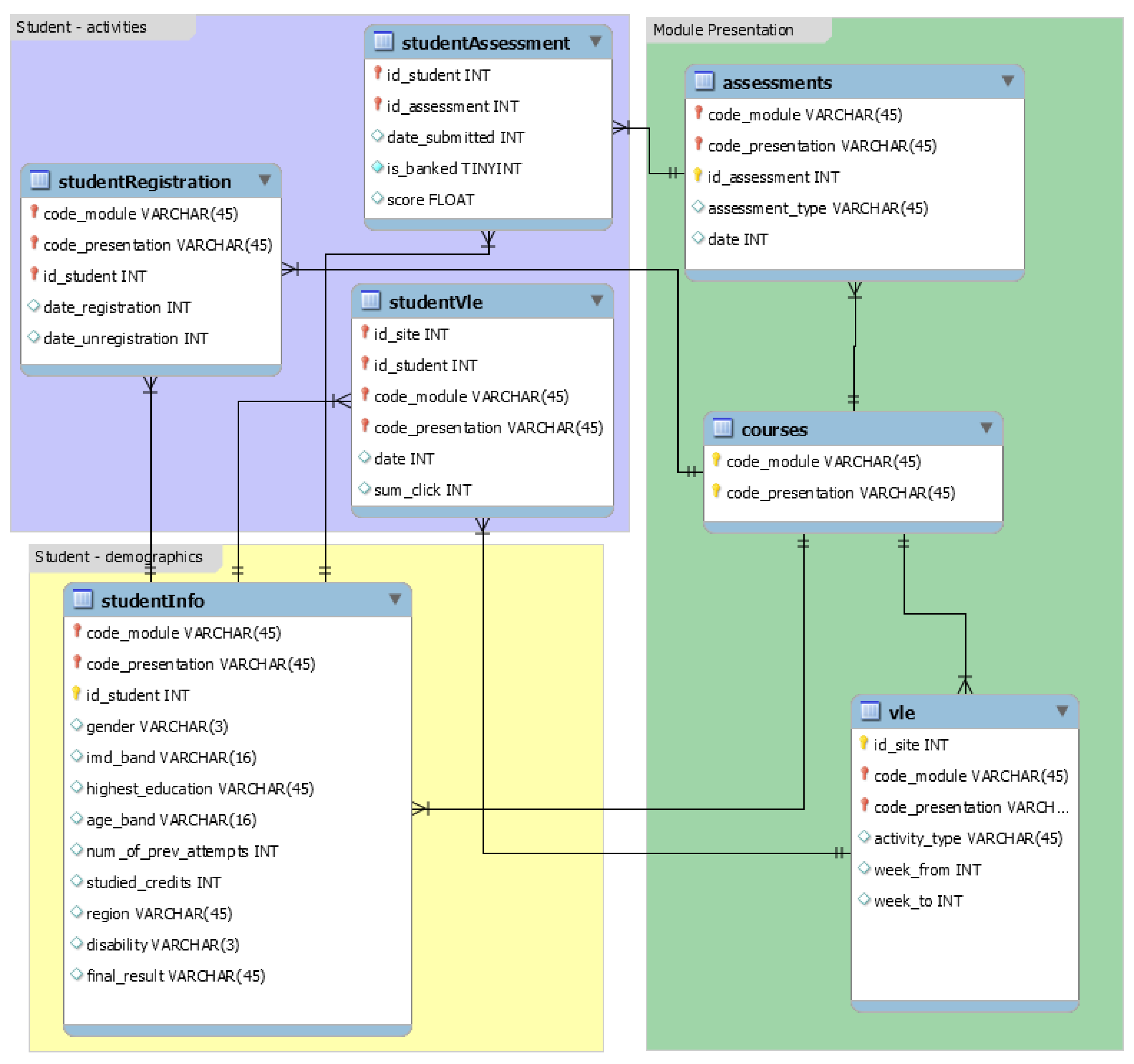
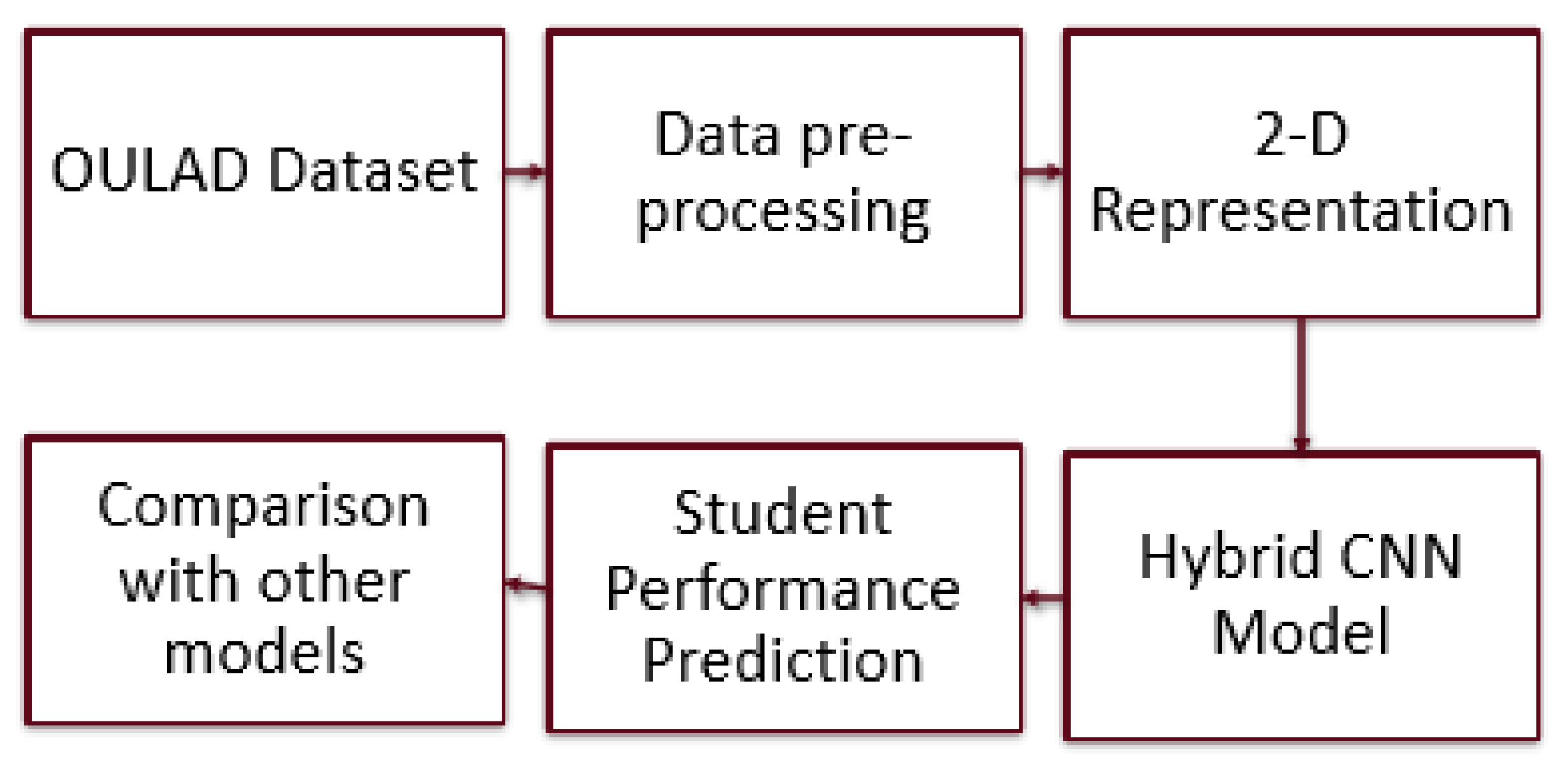
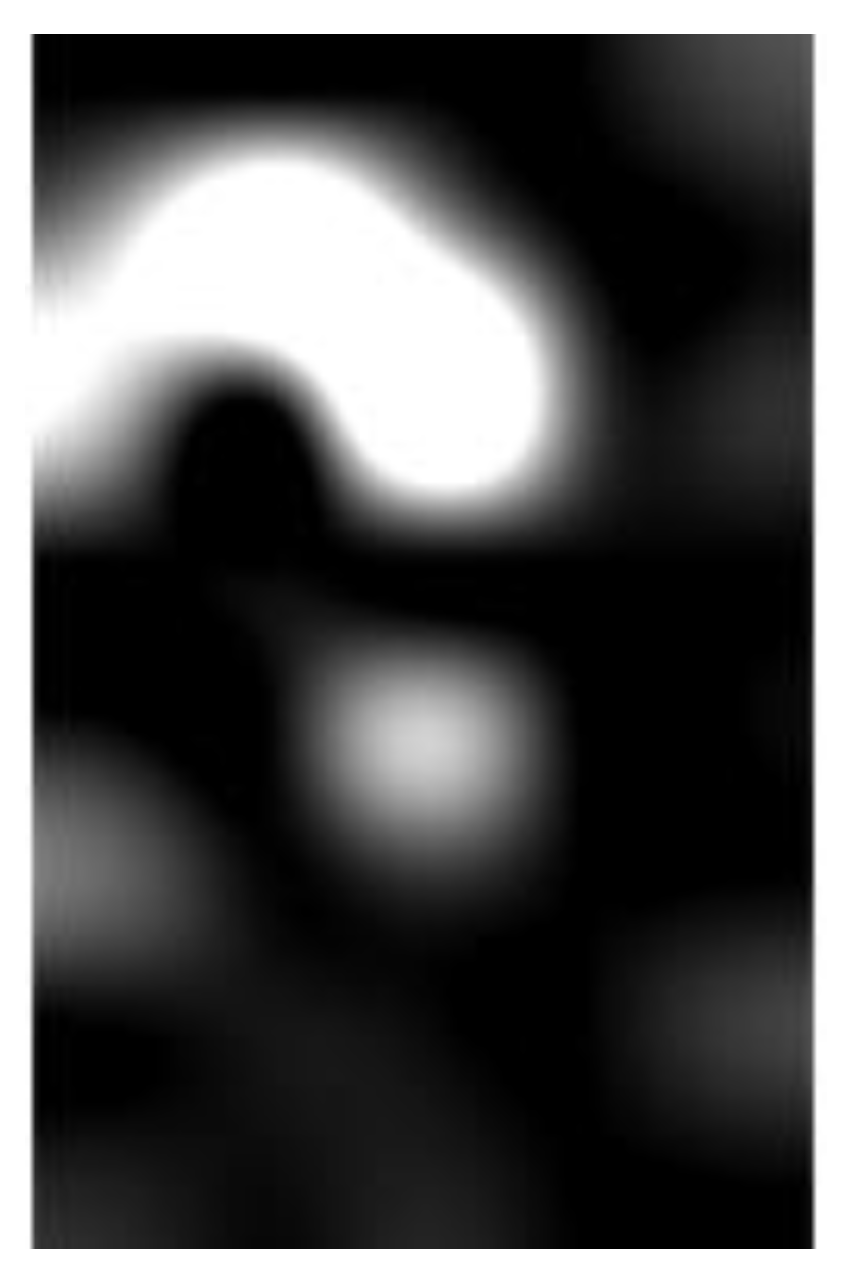
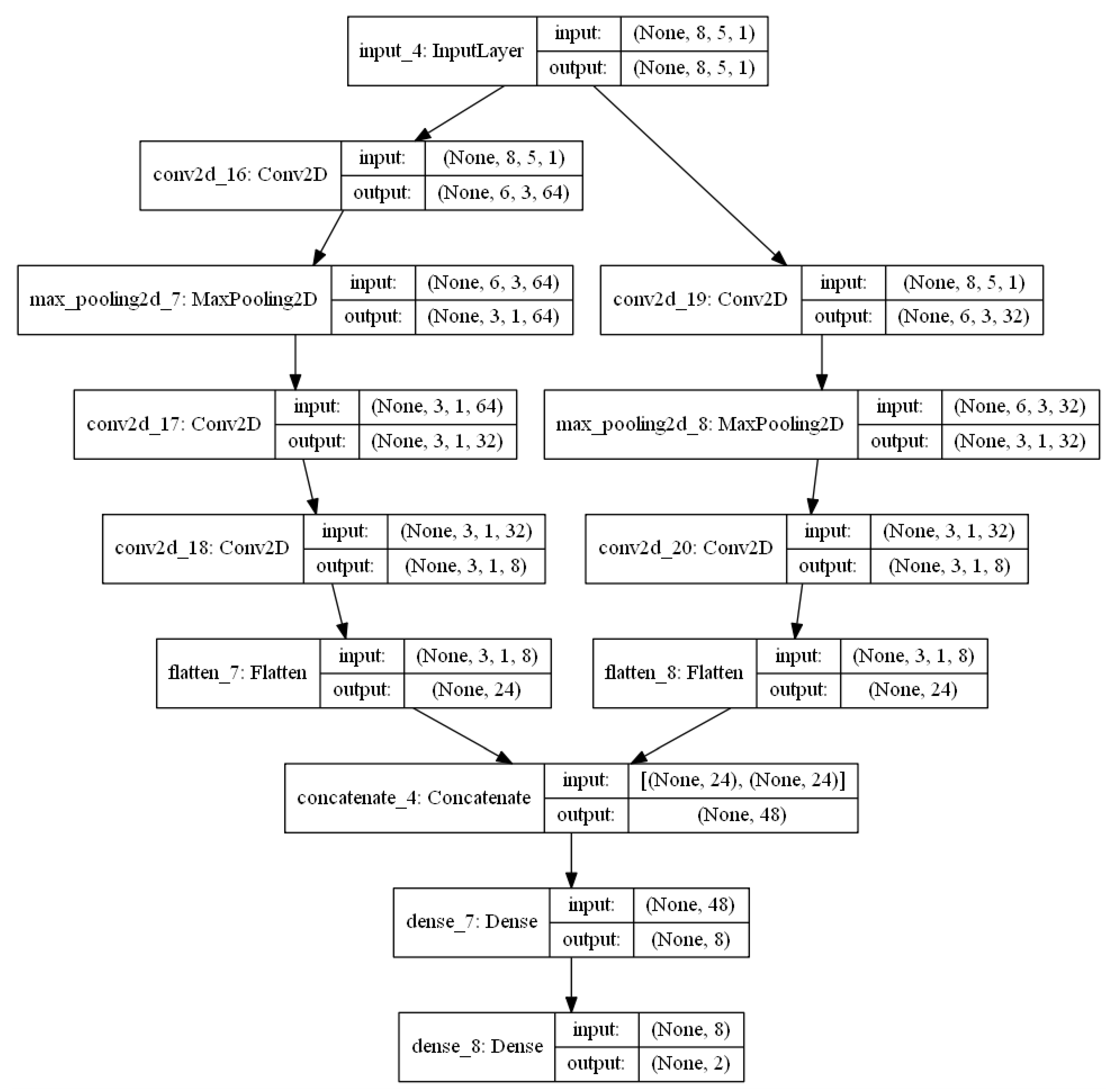

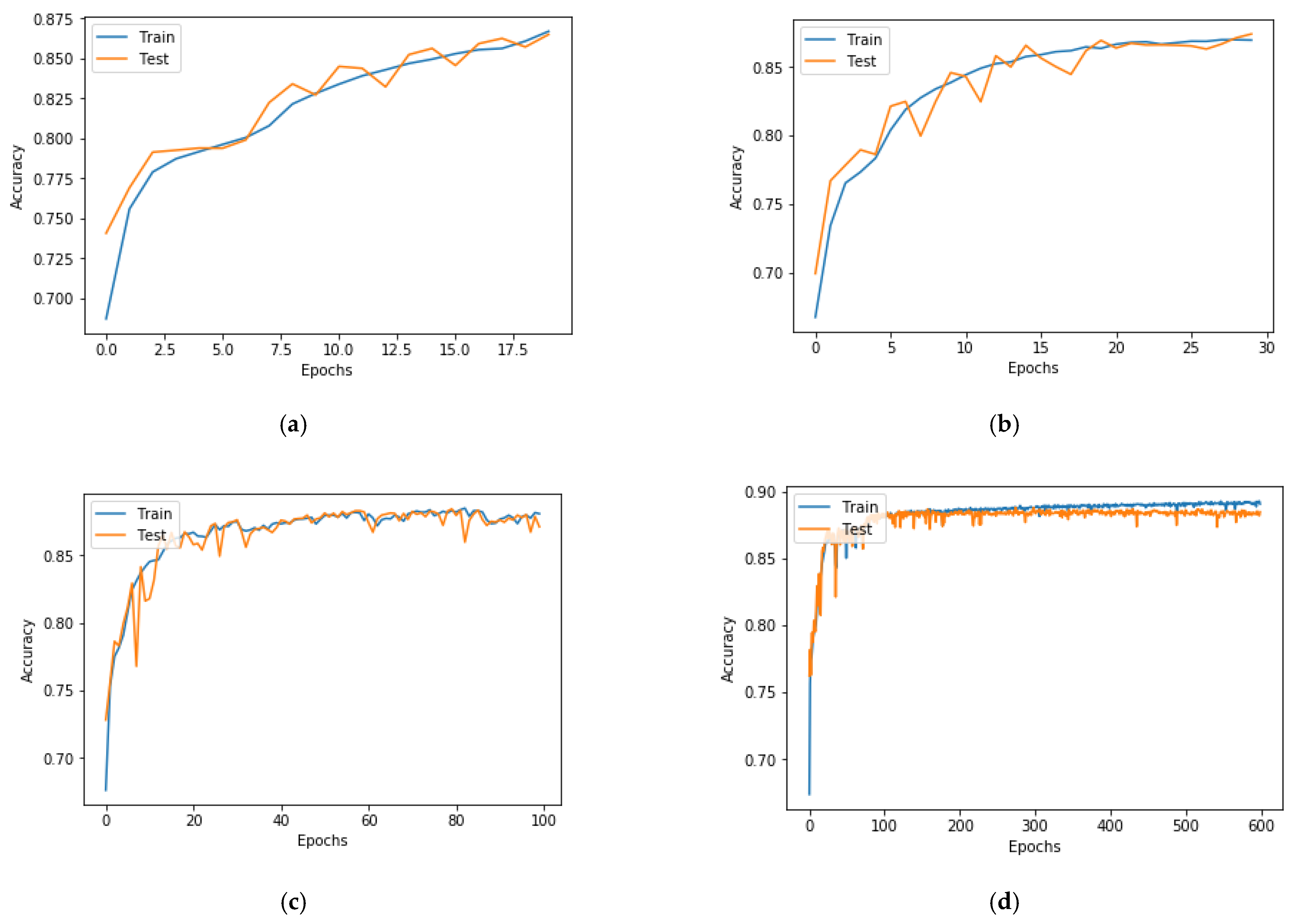
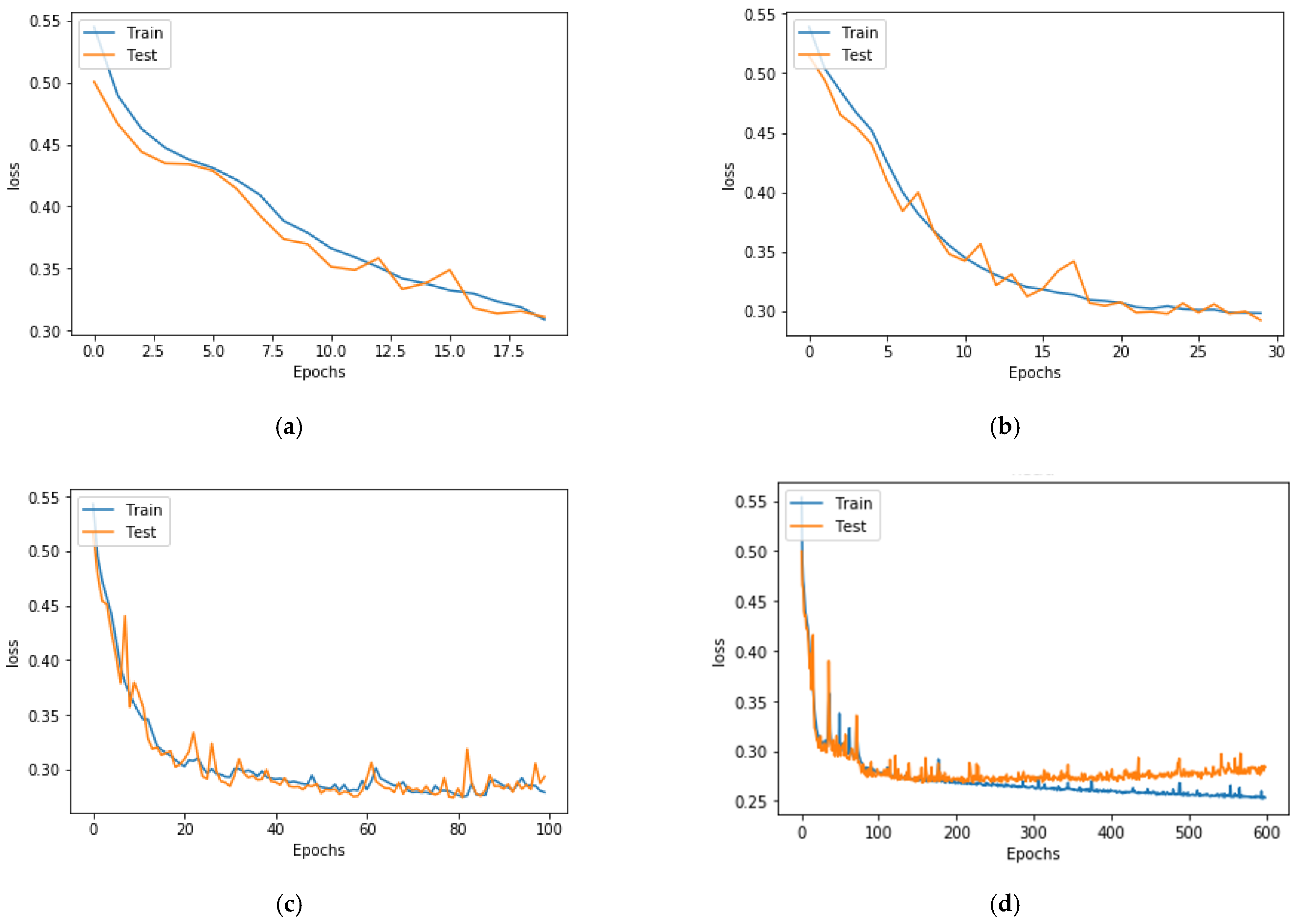
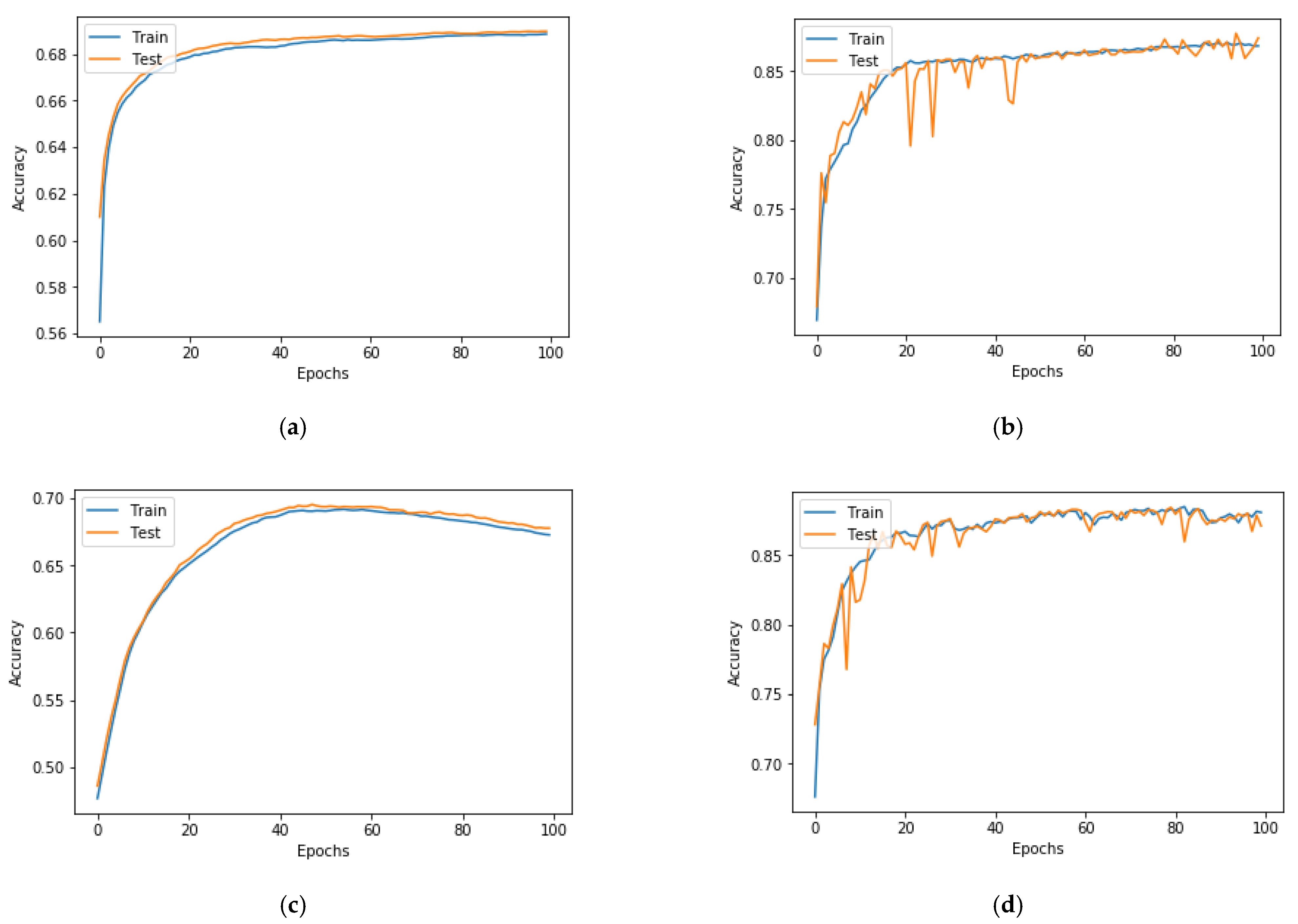


| Learning Rate | Test Loss | Test Accuracy |
|---|---|---|
| 1 | 8.51 | 0.47 |
| 0.1 | 0.69 | 0.53 |
| 0.01 | 0.32 | 0.85 |
| 0.001 | 0.28 | 0.88 |
| 0.0001 | 0.34 | 0.85 |
| 0.00001 | 0.5 | 0.68 |
| Number of Epochs | Test Loss | Test Accuracy |
|---|---|---|
| 20 | 0.32 | 0.86 |
| 30 | 0.29 | 0.87 |
| 100 | 0.28 | 0.88 |
| 600 | 0.28 | 0.86 |
| Optimizer | Test Loss | Test Accuracy |
|---|---|---|
| SGD | 0.63 | 0.69 |
| RMSprop | 0.30 | 0.87 |
| Adadelta | 0.61 | 0.68 |
| Adam | 0.28 | 0.88 |
| Authors | Dataset Used | Techniques | Accuracy |
|---|---|---|---|
| Alberto et al. [54] | OULAD | Decision tree, random forest, extreme gradient boosting, multilayer perceptron | 78.2% using MLP |
| Lubna et al. [55] | Private dataset | NB, KNN, linear discriminant analysis (LDA), SVM, MLP | 76.3% with SVM |
| Song et al. [76] | OULAD | CNN and LSTM | 61% |
| Rizvi et al. [50] | OULAD | DT | 83.14% |
| Azizah et al. [56] | OULAD | Naïve Bayes, DT | 63.8% using NB |
| Hybrid 2D-CNN model | OULAD | Hybrid 2D CNN | 88% |
Publisher’s Note: MDPI stays neutral with regard to jurisdictional claims in published maps and institutional affiliations. |
© 2022 by the authors. Licensee MDPI, Basel, Switzerland. This article is an open access article distributed under the terms and conditions of the Creative Commons Attribution (CC BY) license (https://creativecommons.org/licenses/by/4.0/).
Share and Cite
Poudyal, S.; Mohammadi-Aragh, M.J.; Ball, J.E. Prediction of Student Academic Performance Using a Hybrid 2D CNN Model. Electronics 2022, 11, 1005. https://doi.org/10.3390/electronics11071005
Poudyal S, Mohammadi-Aragh MJ, Ball JE. Prediction of Student Academic Performance Using a Hybrid 2D CNN Model. Electronics. 2022; 11(7):1005. https://doi.org/10.3390/electronics11071005
Chicago/Turabian StylePoudyal, Sujan, Mahnas J. Mohammadi-Aragh, and John E. Ball. 2022. "Prediction of Student Academic Performance Using a Hybrid 2D CNN Model" Electronics 11, no. 7: 1005. https://doi.org/10.3390/electronics11071005
APA StylePoudyal, S., Mohammadi-Aragh, M. J., & Ball, J. E. (2022). Prediction of Student Academic Performance Using a Hybrid 2D CNN Model. Electronics, 11(7), 1005. https://doi.org/10.3390/electronics11071005







